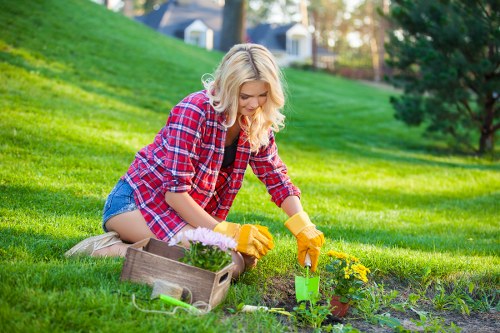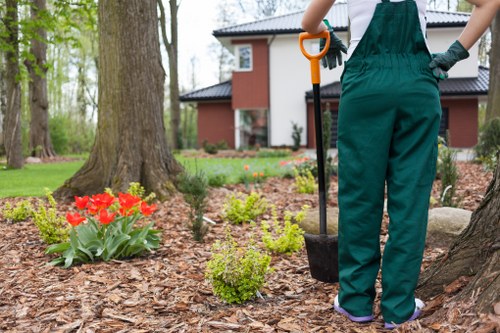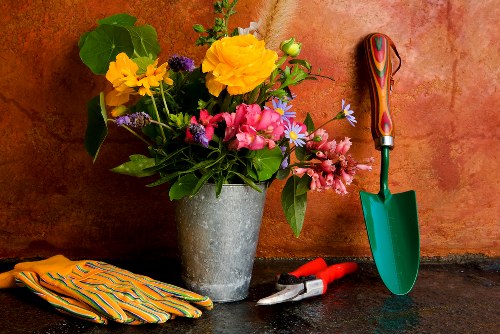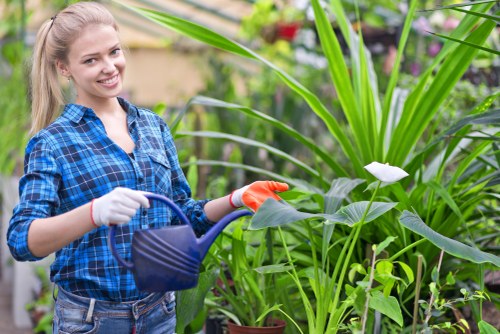Gardening in Woodlands: Embrace Nature’s Serenity in Your Backyard
Introduction to Woodlands Gardening

Gardening in Woodlands offers a unique and enchanting experience for both novice and seasoned gardeners. Nestled among towering trees and lush undergrowth, woodland gardens provide a serene escape from the hustle and bustle of daily life. This guide explores the essentials of creating and maintaining a beautiful woodland garden.
Woodland gardens differ significantly from traditional gardens. They thrive in the dappled shade of trees, rich soil, and often cooler microclimates. Understanding these unique conditions is key to successful gardening in such environments.
In this article, we'll delve into selecting the right plants, designing your garden layout, and maintaining the delicate balance of a woodland ecosystem.
Choosing the Right Plants for Woodland Gardens

Selecting plants that thrive in shaded, moist environments is crucial. Consider native species, as they are well-adapted to the local climate and soil conditions, reducing the need for intensive care.
Key plant types for woodland gardens include:
- Shade-tolerant perennials like hostas and ferns
- Native shrubs such as dogwoods and azaleas
- Ornamental grasses that add texture
- Flowering plants that bring color and fragrance
Incorporating a variety of plant types ensures year-round interest and supports local wildlife, contributing to a vibrant ecosystem.
Designing Your Woodland Garden

Effective woodland garden design harmonizes with the natural surroundings. Start by observing the existing landscape, noting sunlight patterns, soil quality, and existing vegetation.
Consider the following design principles:
- Layering: Create depth by layering plants of varying heights, from groundcovers to canopy shrubs.
- Pathways: Integrate winding paths to encourage exploration and provide access to different garden areas.
- Focal Points: Use standout plants or features like benches, sculptures, or water elements to draw the eye.
Maintaining a naturalistic aesthetic is key; aim to enhance the woodland's inherent beauty rather than imposing a rigid structure.
Soil Preparation and Maintenance

Healthy soil is the foundation of a thriving woodland garden. Conduct a soil test to determine pH levels and nutrient content. Most woodland areas have acidic soil, so select plants that prefer similar conditions.
Soil improvement tips:
- Compost: Enrich the soil with organic matter to improve fertility and structure.
- Mulching: Apply a layer of mulch to retain moisture, suppress weeds, and regulate soil temperature.
- pH Adjustment: Add sulfur or other amendments to lower pH if necessary.
Regular maintenance, such as mulching and occasional fertilizing, will keep your woodland garden healthy and resilient.
Water Management in Woodlands

Proper water management is essential for woodland gardens, which often experience varying moisture levels. Ensure adequate drainage to prevent waterlogging, which can harm plant roots.
Watering strategies:
- Rain Gardens: Incorporate rain gardens to capture and utilize runoff water effectively.
- Swales and Berms: Use swales (shallow ditches) and berms (raised ridges) to direct water flow and manage excess moisture.
- Irrigation Systems: Install drip irrigation for targeted watering, reducing water waste and ensuring plants receive consistent moisture.
By managing water thoughtfully, you can create a sustainable woodland garden that thrives throughout the seasons.
Supporting Wildlife in Your Woodland Garden

A well-designed woodland garden can become a haven for local wildlife. Incorporate elements that provide habitat and food sources for birds, insects, and other creatures.
Wildlife-friendly features:
- Nest boxes and birdhouses: Attract various bird species to your garden.
- Bee hotels: Support beneficial pollinators by providing nesting sites for solitary bees.
- Water sources: Small ponds or birdbaths offer drinking and bathing areas for wildlife.
Encouraging biodiversity not only enhances the beauty of your garden but also promotes a balanced and healthy ecosystem.
Local Relevance: Gardens in Nearby Areas
Gardening in Woodlands is a beloved activity in various nearby areas, each offering unique features and services:
- The Woodlands - Known for its expansive parks and community gardens.
- Spring Creek - Offers specialized native plant nurseries.
- Maple Grove - Famous for its autumn foliage and garden tours.
- Pine Ridge - Home to several botanical gardens and expert horticulturists.
- Oak Harbor - Provides sustainable gardening workshops and eco-friendly supplies.
- Willow Springs - Features serene water gardens and reflective ponds.
- Cedar Valley - Known for its tree care services and arborist expertise.
- Birchwood - Offers a variety of perennial plants and seasonal blooms.
- Elm Park - Hosts annual gardening festivals and community events.
- Hickory Hills - Renowned for its diverse plant species and gardening clubs.
These areas provide excellent resources and inspiration for anyone looking to cultivate their own woodland garden.
Seasonal Care for Woodland Gardens
Maintaining a woodland garden requires attention to seasonal changes. Each season presents unique challenges and opportunities for garden enhancement.
Spring: Focus on planting early bloomers and preparing the soil for new growth.
Summer: Ensure adequate watering and manage pests to keep plants healthy.
Autumn: Rake fallen leaves and mulch to protect plant roots during colder months.
Winter: Protect sensitive plants from frost and plan for the upcoming gardening year.
Tools and Equipment for Woodland Gardening
Equipping yourself with the right tools can make woodland gardening more efficient and enjoyable. Consider the following essentials:
- Hand tools: Pruners, trowels, and cultivators for precise planting and maintenance.
- Watering equipment: Drip irrigation systems or soaker hoses for targeted watering.
- Mulching supplies: Organic mulches like bark or compost to retain soil moisture.
- Garden gloves: Protect your hands while working with plants and soil.
- Wheelbarrows: Facilitate the transportation of soil, plants, and tools.
Investing in quality tools will enhance your gardening experience and contribute to a thriving woodland garden.
Sustainable Practices in Woodland Gardening
Adopting sustainable practices ensures that your woodland garden remains healthy and environmentally friendly. Consider the following tips:
- Composting: Recycle garden waste into nutrient-rich compost to enhance soil fertility.
- Rainwater Harvesting: Collect and utilize rainwater for garden irrigation.
- Native Plants: Choose native species to support local ecosystems and reduce maintenance needs.
- Organic Pest Control: Use natural methods to manage pests without harming beneficial insects.
- Energy-efficient Tools: Opt for manual or battery-powered tools to minimize energy consumption.
Implementing these practices contributes to a sustainable and resilient woodland garden.
Enhancing Aesthetics with Garden Features

Incorporating garden features can enhance the visual appeal and functionality of your woodland garden. Consider adding:
- Water Features: Ponds, fountains, or streams add tranquility and attract wildlife.
- Seating Areas: Benches or gazebos provide spaces for relaxation and contemplation.
- Pathways and Walkways: Define garden sections and make navigation easier.
- Garden Art: Sculptures, mosaics, or decorative elements add personal flair.
- Lighting: Soft lighting highlights garden features and extends enjoyment into the evening.
Thoughtfully placed features can create focal points and enhance the overall ambiance of your woodland garden.
Maintaining Plant Health in Shaded Conditions
Plants in woodland gardens may face challenges such as limited sunlight and competition for nutrients. To maintain their health:
Tips for plant care:
- Pruning: Regularly prune to improve air circulation and reduce disease risk.
- Fertilizing: Use appropriate fertilizers to replenish nutrients without overwhelming the soil.
- Weeding: Keep the area free of invasive weeds that can compete with your plants.
- Monitoring: Regularly check for signs of pests or diseases and address issues promptly.
Proactive maintenance ensures that your woodland garden remains lush and vibrant throughout the year.
Community and Resources for Woodland Gardeners
Joining local gardening communities can provide valuable support and inspiration. Engage with fellow woodland gardeners through:
- Local gardening clubs: Share experiences and exchange tips.
- Workshops and seminars: Learn new techniques and stay updated on best practices.
- Online forums: Connect with a broader community for advice and inspiration.
- Garden tours: Visit other woodland gardens to gain ideas and see successful implementations.
- Nurseries and garden centers: Access a variety of native plants and receive expert guidance.
Leveraging these resources can enhance your gardening knowledge and help your woodland garden flourish.
Conclusion: Embracing the Woodland Garden Lifestyle
Gardening in Woodlands offers a harmonious blend of nature and cultivation, creating a peaceful retreat that supports biodiversity and personal well-being. By selecting the right plants, designing thoughtfully, and maintaining sustainably, you can cultivate a woodland garden that not only thrives but also enriches your life.
Ready to transform your backyard into a woodland paradise? Contact us today to start your gardening journey!
Start Your Woodland Gardening Journey Today
If you're inspired to create your own woodland garden, don't hesitate to book your service now. Our team of experts is here to help you design, plant, and maintain a stunning woodland sanctuary tailored to your needs.
Embrace the tranquility and beauty of a woodland garden, and enjoy the myriad benefits it brings to your home and community.
Join the growing community of woodland gardeners and experience the magic firsthand!
